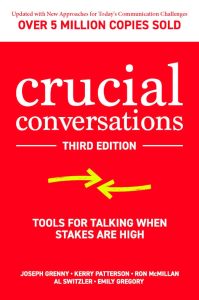 This is another book that I read over 20 years ago, when it first appeared. In fact, I still have my original copy. I bought the new one when a client asked me to come back into her workplace and do some leadership development, communications training and team building with her team. She and her peers in her work place had been reading this book so I wanted to brush up on it as a backdrop to our planning and preparation.
This is another book that I read over 20 years ago, when it first appeared. In fact, I still have my original copy. I bought the new one when a client asked me to come back into her workplace and do some leadership development, communications training and team building with her team. She and her peers in her work place had been reading this book so I wanted to brush up on it as a backdrop to our planning and preparation.
I’m glad I did. It is another meat and potatoes kind of book. Full of “no duh” wisdom.
Unfortunately, most of us are not studying advanced communications, nor are we endeavoring to build a conflict competency, although I think we all should, beginning in grade school. Our desire to be comfortable has gotten in the way of expecting relationships to rupture and learning how to repair them, trusting that, as with torn muscles in weight lifting, the relationship will grow stronger as a result. Friction is a part of life, a part of relationships, and a part of growth. Ideally, we should both expect and welcome it.
It’s like the sand in the oyster that creates the pearl. Necessary and unavoidable. But, oh, look what’s possible as a result of it!
For the rest of us, there are books like Crucial Conversations, that teach us how to have them, how best to approach them, how to set ourselves and others up for success in the process, how to learn from them and move on to the new normals and better days that follow. My two favorite chapters are Learn to Look and Make It Safe. They discuss how to notice when safety is at risk and how to make it safe to talk about anything, respectively. In a world where we are all on edge and so easily and unconsciously triggered, creating safety for all types of conversations and relationships is vitally important, especially if we are leaders in an organization, community or family.
In my worldview, the conversation is the relationship. So, the more we can have meaningful conversations, the whole conversation, fierce, fun, and, yes, crucial conversations, well, the better our relationships will be. This has been my experience and is one of my truths. Like all learning, this doesn’t have to be hard. We can build these muscles together, one day, one skill, one interaction, one meaningful or crucial conversation at a time.
(Find this book in the Recommended Reading section of my website, under: Guiding Principle #2: Keep The Lines of Communication Open [& Get Good At It])





